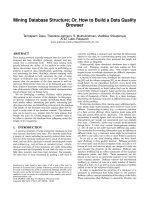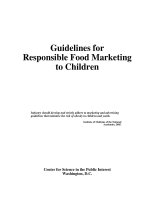Fighting Junk Food Marketing to Kids: a toolkit for advocates doc
Bạn đang xem bản rút gọn của tài liệu. Xem và tải ngay bản đầy đủ của tài liệu tại đây (1.44 MB, 78 trang )
Fighting
Junk Food Marketing
to Kids:
a toolkit
for
advocatesFighting Junk Food Marketing to Kids:
a toolkit for advocates
Berkeley
Media
Studies
Group
Contents
1 Introduction
Why we developed this toolkit, how you can use it
2 Food and Beverage Marketing: Targeting our kids
Unhealthy foods are hurting our kids
Kids’ purchasing power
Food ads target kids
Most food ads are for unhealthy foods
Ethnic target marketing: it’s worse for communities of color
3 Marketing: More than just advertising
Product
Place
Promotion
Price
4 Solutions: What can local communities do?
Product
Place
Promotion
Price
5 Discussion Guide, Activities, and Worksheets
Video Discussion Guide
Including questions on the problem and possible solutions,
for advocates, parents and youth
Activities
Brainstorming
Mapping
Framing
S
tr
at
egizing
W
ork
sheets
Talking about food and beverage marketing that targets kids
Developing strategy worksheet
Sample letter to a merchant
Sam
ple lett
er t
o an af
ter-school program
6 Talking Points and Q&A
7 Resources
F
ighting Junk F
ood Mark
eting to Kids | bmsg.org
4
1
Introduction
Why we developed this toolkit, how you can use it
1 Introduction
1 Introduction
1
Introduction
Imagine, if you will, a big pile of money. Let’s call it a million dollars.
It’s all y
our
s t
o spend, any way you want. What would you buy?
Didn’t t
ake long to spend that money, did it? Well, lucky for you,
an hour later you get another million to spend. Now what would you
do with that money? How about if you got another million dollars an
hour later — and kept it up around the clock, all year long?
Well, now imagine that deluge of money aimed right at our kids
— spent convincing them to eat and drink MORE MORE MORE of
t
he f
oods and be
v
er
ages that are least healthy for them. That’s how
much money the food and beverage industry in the U.S. spends to
r
eac
h our children with their messages: one million dollars an hour,
every hour of every day, targeted at children and youth. It adds up
t
o $10 to $12 billion dollars a year spent on youth marketing alone.
F
ighting Junk F
ood Mark
eting to Kids | bmsg.org
5
F
ighting Junk F
ood Mark
eting to Kids | bmsg.org
6
I
t’s natural to feel overwhelmed by this amount of marketing —
but in fact, there are many things that local groups can do, in their
own communities, to limit marketing and counter its effect.
We developed this toolkit to help community advocates under-
s
tand how food marketing affects kids’ health and what they can do
about it at the local level. This toolkit is designed to be used in con-
junction with our video,
Fighting Junk Food Marketing to Kids, which
illustrates community-based actions to address marketing. We hope
you will use this notebook and the video as community organizing
tools to stimulate local advocacy for policies that limit the impact of
food and beverage marketing to kids. The activities and discussion
guides included here will help you use the toolkit to discuss market-
ing and what your community can do about it in many settings:
At community meetings
With school leadership
With youth
At neighborhood house parties
At coalition meetings
With merchants, after-school program directors, and others
who have the power to limit some kinds of marketing
Why talk about policy when the problem of healthy eating and
active living is ultimately an individual struggle? We believe that
while individual choices about health are important, the environ-
ment is critical in shaping those choices. Behavior happens in a
context. For example, we might be able to educate everyone about
the value of eating fruits and vegetables daily, but if there’s no
place to buy reasonably priced fresh produce, then no one has the
opportunity to eat it, no matter how motivated or educated they are.
Our commitment is to support advocates in shaping their envi-
ronment, to make their local community a place where the healthy
choice is — on all levels — the easiest choice to make.
A
cknowledgements
We gratefully acknowledge the California Endowment for their sup-
p
ort of this project.
W
e also thank our partners in the Healthy Eating, Active
Communities (HEAC) Initiative:
California Project LEAN
CANFit
Common Sense Media
Partnership for the Public’s Health
PolicyLink
Prevention Institute
Public Health Institute
Public Health Law Program
Samuels and Associates
Strategic Alliance
We especially appreciate the excellent work of the California Pan-
Ethnic Health Network and Consumers Union, and their report
Out
of Balance: Marketing of Soda, Candy, Snacks and Fast Foods
Drowns Out Healthful Messages (September 2005), which con-
tributed to the conception of this toolkit.
We thank the Public Health Law Program for helping us understand
the legal implications of various strategies to combat marketing. We
thank Prevention Institute and Strategic Alliance for allowing us to
use some of their Rapid Response Network talking points in this
toolkit.
We dedicate this toolkit to the local advocates in HEAC communities
across California who are making their communities places where
healt
hy eating and active living are the natural thing to do:
Baldwin Park
Chula Vista
Oakland
Santa Ana
Shas
ta
South Los Angeles
Katie Woodruff, MPH
Berkeley Media Studies Group
Berkeley, California
www.bmsg.org
August 2006
F
ighting Junk F
ood Mark
eting to Kids | bmsg.org
7
F
ighting Junk F
ood Mark
eting to Kids | bmsg.org
8
2
Food and Beverage Marketing: Targeting our kids
Unhealthy foods are hurting our kids
Kids’ purc
hasing po
wer
Food ads target kids
Most food ads are for unhealthy foods
Ethnic target marketing: it’s worse for communities of color
2 Food and Beverage Marketing:
Targeting our kids
2 Food and Beverage Marketing:
Targeting our kids
2
Food and Beverage Marketing:
Targeting our kids
Unhealthy foods are hurting our kids:
Since 1980, overweight rates have doubled among children and
tripled among adolescents.
1
Mor
e t
han one out of e
very three U.S.
c
hildr
en born in 2000 is expected to get diabetes in their lifetime.
2
F
ighting Junk F
ood Mark
eting to Kids | bmsg.org
9
1
CDC, National Center for Health
S
t
atis
tics, Pr
e
valence of Overweight
Among Childr
en and A
dolescents:
U
nited States, 1999-2002, available at
/>products/pubs/pubd/hestats/
o
v
er
wght99.htm
2
CDC, N
ational Cent
er for Chronic
Disease Pr
evention and Health
Promotion, Diabetes Public Health
Resource, CDC Statements on
Diabetes Issues,
/>docs/lifetime.htm
F
ighting Junk F
ood Mark
eting to Kids | bmsg.org
10
3
Centers for Disease Control, “CDC’s
KidsMedia: Physical Activity and
Youth,” available at
/>background.htm. Cited in Linn S,
Consuming Kids, Anchor Books, New
York, 2004.
4
Pavkov ME et al, “Effect of Youth-
Onset Type 2 Diabetes Mellitus on
Incidence of End-Stage Renal Disease
and Mortality in Young and Middle-
Aged Pima Indians,”
Journal of the
American Medical Association,
296:421-426, July 26, 2006.
5
Olshansky SJ et al, “A potential
decline in life expectancy in the United
States in the 21
st
century,” New
England Journal of Medicine,
352:1138-1145, March 17, 2005.
6
Hedley AA, Ogden CL, Johnson CL,
Carroll MD, Curtin LR, Flegal KM,
“Prevalence of overweight and obesity
among US children, adolescents and
adults 199-2002,” JAMA, 2004; 291:
2847-2850.
7
Out of Balance: Marketing of Soda,
Candy, Snacks and Fast Foods Drowns
Out Healthful Messages.
CPEHN and
Consumers Union report, September
2005.
8
US Dept. of Agriculture, “Changes
Over 25 Years in the Dietary Intakes of
Children 6-19 years” (April 2005), cour-
tesy of author Rhonda Sebastian, cited
in
Out of Balance: Marketing of Soda,
Candy, Snacks and Fast Foods Drowns
Out Healt
hful Messag
es.
CPEHN and
Consumers Union report, September
2005.
9
Jacobson MF. Liquid candy: how soft
drinks are harming Americans’ health.
W
ashingt
on, DC: Cent
er for Science in
the Public Interest; 2005.
/>10
Ludwig DS et al., “Relation between
consumption of sugar-sweetened
drink
s and c
hildhood obesity: A
prospective, observational analysis,”
Lancet 357:505-508, 2001.
11
Ebbeling CB, et al. Effects of
decreasing sugar-sweetened beverage
consumption on body weight in adoles-
cents: a randomized, controlled pilot
study.
Pediatrics. 2006;117:673-80.
A
ccording to the CDC, among overweight children between 5
and 10 years of age, 60 percent already have at least one cardio-
vascular disease risk factor that can lead to atherosclerosis, hyper-
tension, and diabetes in adulthood.
3
T
his is particularly critical because, as a recent study con-
firmed, development of Type 2 diabetes before age 20 leads to a
high risk of kidney disease and death by middle age.
4
Today’s gen-
eration of children is the first in modern history that is expected to
have shorter life spans than their parents, due to the chronic dis-
eases associated with poor nutrition, inactivity and obesity.
5
People of color in the U.S. disproportionately suffer from obesi-
ty, overweight, and chronic illnesses such as diabetes and cardio-
vascular disease. The disparity is especially true in children:
28.2% of white children age 6-19 are overweight or at risk
for overweight;
35.4% of black children are overweight or at risk;
39.9% of Mexican-American children are overweight or at
risk .
6
Consumption of foods high in calories, fat and sugars, such as
sodas, fast food, packaged snack foods and desserts, accounts for
much of the increase in overweight among children. Nearly 20% of
caloric intake among 12-to-18 year olds comes from fast food, com-
pared with 6.5% in the late 1970s.
7
In 2002, soda composed 50%
of the total beverage intake for kids aged 12-19, a 58.5% increase
since 1977, while milk consumption decreased nearly 9% for teens
and more than 20% for children aged 6-11.
8
At the start of the
twenty-first century, the average teenage boy in the U.S. consumed
two cans of soda a day, and teenage girls drank a little more than
one 12-ounce can of soda per day.
9
This is a concer
n because children who drink more soft drinks
are more likely to become overweight,
1
0
and a recent study found
that decreasing children’s consumption of sugar-sweetened drinks
resulted in improved Body Mass Indexes (BMIs) for those originally
at a higher BMI.
1
1
F
ighting Junk F
ood Mark
eting to Kids | bmsg.org
11
1
2
Brown R and Washton R, “The Kids
Market in the US,” Packaged Facts,
May 1, 2006. http://www.
packagedfacts.com/pub/
1119536.html
13
Horgan KB et al, “Television Food
Advertising: Targeting children in a
toxic environment,” in Singer and
Singer,
Handbook of Children and the
Media,
Sag
e Publications, 200
1
. Cited
in “Raising Media Savvy Kids: A
Common Sense Toolkit,” Common
Sense Media, 2005.
14
Advertising Age, “100 Leading
N
ational A
dv
ertisers,” June 26, 2006.
www.adage.com/images/random/
lna2006.pdf
15
Harrison K, Marske A, “Nutritional
content of foods advertised during the
t
ele
vision pr
ograms children watch
most,” American Journal of Public
Health, 2005; 95:1568-1574.
16
Out of Balance: Marketing of Soda,
Candy, Snacks and Fast Foods Drowns
Out Healthful Messages.
CPEHN and
Consumers Union report, September
2005.
K
ids are a primary market:
Marketers want to reach children not only to sell their products now
b
ut to develop customers for life. Marketing may influence children
to develop positive feelings about a branded food or beverage
b
efore they even get a chance to taste it, leading to the industry’s
dream achievement: “cradle-to-grave brand loyalty.” To make this
happen, food marketers reach out to children constantly, starting
when they are very young.
Corporations understand that children are a lucrative market.
Kids in the U.S. have tremendous purchasing power: children
between 3 and 11 years old bought or influenced the purchase of
$18 billion worth of products and entertainment in 2005.
12
Advertising of unhealthy foods far outweighs that of healthier foods:
Food is advertised in more than half of all ads targeting children,
and children see an average of one food ad for every five minutes
of Saturday morning TV they watch.
13
Advertising Age reported that $12.38 billion was spent on
“measured media” advertising alone by the food, beverage and
restaurant industries in 2005.
14
This includes TV, radio, magazine,
newspaper, billboard and Internet ads; TV is where the majority of
these advertising dollars are spent, by far.
The foods advertised on television are generally not healthy.
One recent study found that packaged snack foods, fast foods, and
sweets accounted for 83% of foods advertised during TV shows
heavily viewed by children.
15
By comparison, the California Pan Ethnic Health Network and
Consumers Union found that a mere $9.55 million was spent in
2004 on communications for the federal and California “5 A Day”
programs (which promote eating five fruits and vegetables a day for
better health). With industry expenditures more than one thousand
times greater than the 5 A Day budgets, “it is no wonder that
healthful dietary messages from government, parents and others
are barely audible,” according to CPEHN and CU.
16
F
ighting Junk F
ood Mark
eting to Kids | bmsg.org
12
Notable Voices:
“Corporate America doesn’t spend $10 billion a year on [food]
advertising aimed at children on the off chance that it might be
effective. No. It spends $10 billion because that advertising works
brilliantly. . . because it persuades children to demand — to the
point of throwing temper tantrums, if necessary — a regular diet of
candy, cookies, sugary cereal, sodas, and all manner of junk food.
That’s why most of the fast-food chains market expressly to chil-
dr
en, r
olling out ad campaigns using popular cartoon characters
and mo
vie figures.”
Senat
or T
om Harkin,
in a speec
h t
o t
he
7
t
h
Annual KidScreen Summit
F
ebr
uary 8, 2006
F
ighting Junk F
ood Mark
eting to Kids | bmsg.org
13
17
Dir
ect q
uot
e fr
om The N
ational
A
cademies pr
ess r
elease, 1
2/6/05,
“Food Marketing Aimed at Kids
Influences Poor Nutritional Choices,
IOM Study Finds; Broad Effort Needed
to Promote Healthier Products and
Diets.”
18
Food Marketing to Children and
Youth: Threat or Opportunity?
Institute
of Medicine, December 2005.
19
Ibid.
20
Kunkel D, “Children and Television
Advertising,” in Singer and Singer,
Handbook of Children and the Media,
Sage Publications, 2001.
T
he evidence is in: Children’s diets are adversely affected by food marketing:
In December 2005, the Institute of Medicine released Food
M
arketing to Children and Youth: Threat or Opportunity?
,
an
exhaustive review of the scientific evidence on food marketing to
c
hildren and obesity. This report contained two key findings:
Food and beverage marketing targeted to children ages 12
and under leads them to request and consume high-calo-
rie, low-nutrient products.
17
The dominant focus of marketing to children and youth is
on foods and beverages high in calories and low in nutri-
ents, and is sharply out of balance with healthful diets.
18
Practices such as using popular cartoon characters on food packag-
ing and in ads are particularly persuasive. Even the food and bever-
age industry’s own Children’s Advertising Review Unit (CARU) admit-
ted that “the mere appearance of a character with a product can
significantly alter a child’s perception of the product.”
19
The effect of advertising is even stronger on younger children.
Children under the age of 8 do not recognize the persuasive intent
of ads and tend to accept them as accurate and unbiased.
20
I
t’s even worse for communities of color:
Just as people of color in the U.S. suffer disproportionately from
o
besity, overweight, and chronic illnesses such as diabetes and car-
diovascular disease, they are also disproportionately targeted by the
f
ood industry.
Food companies and advertisers reach communities of color
through targeted advertising — campaigns designed for and placed
specifically in media and TV shows whose audiences are largely
made up of people of color. In 2005, food, beverage, candy and
restaurant companies spent nearly $512 million to advertise in
Hispanic media, outspent only by the automotive industry.
21
Six of
the top 10 advertisers on BET (Black Entertainment Television) in
1999 were food or beverage companies, which together spent
$30.5 million to pitch their goods to BET viewers that year.
22
The foods and beverages marketed to African-Americans and
Latinos are often not as healthy as those marketed to general audi-
ences. For instance, a recent survey of prime-time TV programs
found that far more food commercials appear on shows with large
African-American audiences than those for general audiences, and
that most of these ads are for “fast food, candy, soda, or meat (e.g.,
sausages, cold cuts.)”
23
F
ighting Junk F
ood Mark
eting to Kids | bmsg.org
14
2
1
Advertising Age’s “Hispanic Fact
Pact, Annual Guide to Hispanic
Advertising and Marketing,” 2006 edi-
tion, pag
e 10.
22
Williams, JD, working paper,
A
dv
er
tising expenditur
es b
y firm and
brand in African American-oriented
electronic and print media: An analysis
of 1999 competitive media reporting
(CMR) data,
University of Texas at
Austin advertising department, 2005.
Cit
ed in
Out of Balance: Mark
eting of
Soda, Candy, Snacks and Fast Foods
Drowns Out Healthful Messages.
CPEHN and Consumer
s U
nion r
epor
t,
Sept
ember 2005.
23
Hender
son V, Kelly B, “Food adver-
tising in the age of obesity: Content
analysis of food advertising on general
mark
et and African American t
ele
vi
-
sion,
” Jour
nal of Nutrition Education
and Beha
vior, July-August 2005; 5-85.
Cited in
Out of Balance: Marketing of
Soda, Candy, Snacks and Fast Foods
Drowns Out Healthful Messages.
CPEHN and Consumers Union report,
September 2005.
3
More than just advertising
Product
Place
Promotion
Price
3 Marketing:
Mor
e t
han jus
t advertising
3 Marketing:
More than just advertising
3
Marketing: More than just advertising
People are usually most aware of the ads that kids watch on TV, but
it’s im
por
t
ant to realize that marketing is far broader and more
wide-r
eaching than that. In fact only 20% of all food and beverage
marketing in 2004 was devoted to ads on TV, radio, print, billboards
or the internet.
F
ighting Junk F
ood Mark
eting to Kids | bmsg.org
15
$10.5 billion
per year
T
he food and beverage industry spends $10-12 billion a year —
that’s one million dollars every hour of every day — just to reach
children and youth. Of that:
$1 billion is spent on advertising to kids (primarily on TV);
$4.5 billion goes to youth-targeted promotions such as pre-
m
iums, coupons, sweepstakes and contests;
$2 billion is spent on youth-targeted public relations, such
as efforts to place articles about the product in youth
media;
$3 billion goes to packaging designed for children.
24
Youth-Targeted Food and Beverage Marketing
F
ighting Junk F
ood Mark
eting to Kids | bmsg.org
16
24
IOM Fact Sheet “Advertising,
Marketing and the Media: Improving
Messages,” September 2004. Drawn
from
Preventing Childhood Obesity:
Health in the Balance
, 2005.
Youth PR
$2 billion
$10.5 billion
per year
Packaging
$3 billion
Promotions
$4.5 billion
TV Ads
$1 billion
F
ighting Junk F
ood Mark
eting to Kids | bmsg.org
17
25
Quot
ed in Children Now’s Policy
Brief, “Interactive Advertising and
Children: Issues and Implications,”
Summer 2005. http://www.
childrennow.org/assets/pdf/
issues_media_iadbrief_2005.pdf
Notable Voices:
“It is important to recognize that young children are [already] being
manipulated rather effectively by television ads that are not
interactive and not tailored to the individual child. As there is more
tailoring and more interactive capability, advertising is going to be
more powerful than ever before. I think that’s what underscores the
need for more regulatory intervention.”
Dale Kunkel, PhD
Professor of Communication
University of Arizona
25









